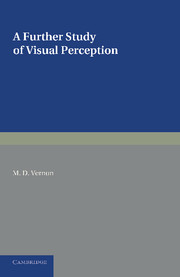Book contents
- Frontmatter
- Contents
- List of Illustrations
- Acknowledgements
- Chapter I INTRODUCTION
- Chapter II THE NATURE OF PERCEPTION
- Chapter III THE PERCEPTUAL PROCESS
- Chapter IV THE DETERMINATION OF FORM
- Chapter V SPATIAL PERCEPTION
- Chapter VI THE CONSTANCIES
- Chapter VII THE FUNCTIONS OF THE FRAMEWORK IN PSYCHO-PHYSICAL EXPERIMENTS
- Chapter VIII THE PERCEPTION OF MOVEMENT
- Chapter IX MICHOTTE'S STUDIES OF SOME INTRINSIC PHENOMENA OF EXPERIENCE
- Chapter X THE INFLUENCE OF INTERNAL AND INDIVIDUAL FACTORS UPON PERCEPTION
- Chapter XI CONCLUSION
- Appendix A
- Appendix B
- References
- Index of Authors
- Index of Subjects
Chapter X - THE INFLUENCE OF INTERNAL AND INDIVIDUAL FACTORS UPON PERCEPTION
Published online by Cambridge University Press: 05 June 2016
- Frontmatter
- Contents
- List of Illustrations
- Acknowledgements
- Chapter I INTRODUCTION
- Chapter II THE NATURE OF PERCEPTION
- Chapter III THE PERCEPTUAL PROCESS
- Chapter IV THE DETERMINATION OF FORM
- Chapter V SPATIAL PERCEPTION
- Chapter VI THE CONSTANCIES
- Chapter VII THE FUNCTIONS OF THE FRAMEWORK IN PSYCHO-PHYSICAL EXPERIMENTS
- Chapter VIII THE PERCEPTION OF MOVEMENT
- Chapter IX MICHOTTE'S STUDIES OF SOME INTRINSIC PHENOMENA OF EXPERIENCE
- Chapter X THE INFLUENCE OF INTERNAL AND INDIVIDUAL FACTORS UPON PERCEPTION
- Chapter XI CONCLUSION
- Appendix A
- Appendix B
- References
- Index of Authors
- Index of Subjects
Summary
LEVELS OF ATTENTION
We have now discussed in detail the main categories into which the phenomena of visual perception may be grouped. We have investigated the principles governing the perception of shapes and of objects; the spatial setting within which they are arranged, and their relationship to which plays so large a part in their perceived qualities; and the phenomena of movement which seem to exist to some extent independently of the objects moving. This discussion has related in the main to the phenomenal qualities of the external world. Although, as we have shown, these qualities are to a great extent determined by certain schemata common to the minds of most observers, yet it is equally clear that they are in fact attributed by the observer to the external world and the objects within it. We must now turn to consider those attributes of the perceptual experience which the observer always regards as being a function of his own mind.
We shall deal first with the attribute of ‘attention’. Whatever the controversy as to the exact nature of attention, it cannot be denied that every observer thinks of his ‘attention’ as existing in himself. It may be stimulated by certain external conditions and events, but it is never projected upon them. Thus one speaks of being ‘forced to attend’ to a particular stimulus, but not of a stimulus being ‘attentional’. In attending, the observer considers that from time to time the clearness, accuracy, and detail with which he perceives any particular object or set of objects vary irrespectively of the nature of these objects. This variation may occur spontaneously, or be brought about deliberately, but it is felt to occur within the observer's own consciousness, and is not attributed to the objects as a function of their intrinsic nature.
This is not to deny that variations in the degree of clarity of perception may be closely related to, or even determined by, qualities of the objects in the external world. Dallenbach (1920), for instance, preferred to use the word ‘clearness’ for what had often been termed ‘attention’.
- Type
- Chapter
- Information
- A Further Study of Visual Perception , pp. 200 - 256Publisher: Cambridge University PressPrint publication year: 2013



